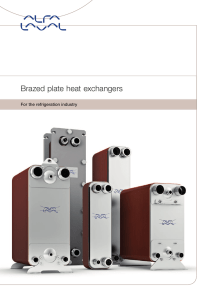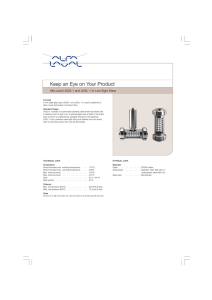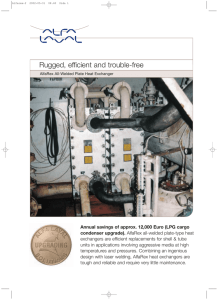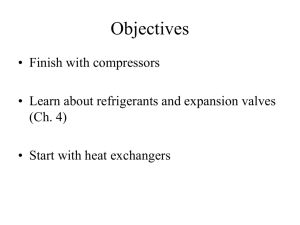Evaporators
advertisement
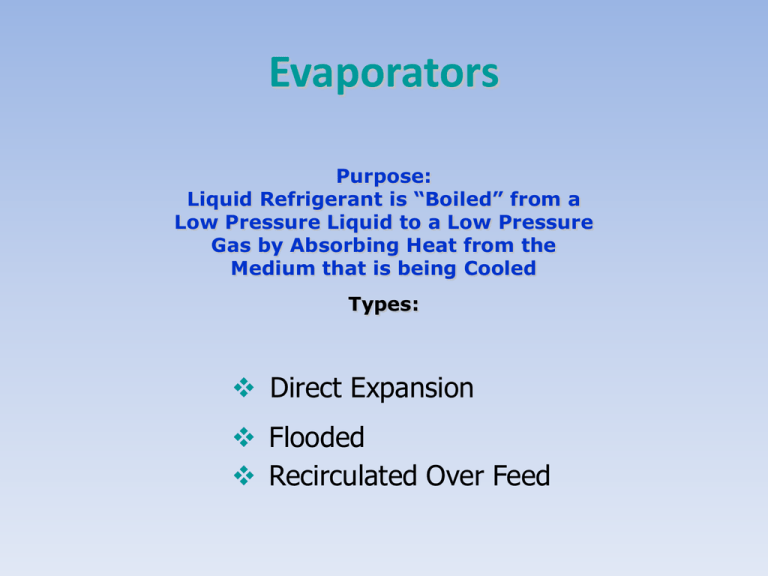
Evaporators Purpose: Liquid Refrigerant is “Boiled” from a Low Pressure Liquid to a Low Pressure Gas by Absorbing Heat from the Medium that is being Cooled Types: Direct Expansion Flooded Recirculated Over Feed Direct Expansion Evaporators Liquid Refrigerant Enters the Evaporator, Absorbs Heat from the fluid to be cooled, Evaporates and Exits the Evaporator as 100% Gas The Liquid Refrigerant Entering the Evaporator is Regulated by a Thermo Expansion Valve (TXV) which Meters out only enough Refrigerant to Ensure Dry Gas out of the Evaporator; the Amount is based on Demand or Load Imposed on the Evaporator It has a Smaller Refrigerant Charge, but does not use the heat exchanger as efficiently as other types of feed. Direct Expansion Evaporators Shell and Tube Evaporator Referred to in the Industry as a “Chiller” Liquid Refrigerant is Passed into the Lower Tubes while Traveling Back and Forth through a Number of Passes Liquid Refrigerant Absorbs the Heat from the Brine and Evaporates (Gas) The Refrigerant Gas is Drawn Back to the Suction of the Compressor Flooded Evaporators Evaporator is Kept Nearly Filled (or Flooded) with Liquid Refrigerant through its Entire Surface Refrigerant Enters Evaporator as 100% Liquid and Exits with Some Carry-Over of Liquid (e.g.. 80% Gas; 20% Liquid) In most applications, Flooded Evaporators are Connected to a Surge Drum Flooded Evaporators Surge Drums either Provide a Constant Source of Liquid Refrigerant or Ensure an Adequate Separation Space between the Liquid Refrigerant and the Suction Gas Back to the Compressor, or Do Both It has the Advantage of being the Most Efficient type of Evaporator, but has a Larger Refrigeration Charge Flooded Evaporators Shell and Tube The Liquid Refrigerant is Contained within the Shell of the Evaporator The Tubes Carrying the Brine or Glycol to be Cooled are Immersed in the Liquid Refrigerant The Refrigerant Vapor that is Produced by the Heat of the Brine flowing through the Tubes is Taken Back off the Top of the Surge Drum Flooded Evaporators Plate and Frame Ammonia is Contained between Two Welded Plates The Brine is in Contact with Both Sides of the Gasketed Plate The Plates have a “Herringbone” Design = Greater Surface Area Flooded Evaporators Plate and Frame Advantages: Less Refrigerant Charge No Corrosion; 304/316 Stainless Steel or Titanium, Higher Operating Suction Temperature, and Smaller Footprint Chiller/Transfer Page 10 Chiller/Transfer Page 11 Chiller/Transfer Page 12 Chiller/Transfer Page 13 Chiller/Transfer Page 14 Finned-Tube Evaporators A finned-tube evaporator includes rows of tubes passing through sheets of formed fins. Liquid refrigerant flows through the tubes, cools the tube and fin surfaces. When air passes through the coil and comes into contact with the cold fin surfaces, heat is transferred from the air to the refrigerant. Causes the refrigerant to boil and leave the evaporator as vapor as heat is transferred. The fins of the coil are formed to produce turbulence as the air passes through them. This turbulence enhances heat transfer, preventing stratification within the coil-leaving air stream. Producing cooled air comparing with shell-and-tube type which is for chilled water. Liquid Overfeed Liquid is pumped from an Accumulator to the Air Units. A portion of the liquid boils off while a greater amount by weight returns to the accumulator as a liquid. The liquid enters at nearly the same temperature as the suction temperature reducing flash load. Efficiencies similar to flooded evaporators except for the pump power. MUCH less complicated piping and controls at the evaporator/air unit Plate Heat Exchanger Types and Maintenance Presented by: Mark Muncy – Alfa Laval Inc., Louisville, KY October 18, 2007 © Alfa Laval 2001 Slide 18 Discussion Outline • Basic Heat Transfer • Compact solutions for Liquid/Liquid applications •Gasketed plate •Semi-Welded plate heat exchanger •Welded plate heat exchanger •Compabloc •Spiral heat exchanger • Compact solutions for Two-Phase applications (evaporation and condensing) • Maintenance of compact heat exchangers • Questions © Alfa Laval 2001 Slide 19 Data needed to design any heat exchanger • Flows and temperatures for both sides • Fluid properties including: density, specific heat, thermal conductivity, and viscosity for at least two points. • For condensers and evaporators, data such as a condensing curve, boiling point elevation, and/or other parameters may be required. • Process conditions and limitations such as system pressure, potential for fouling or plugging, pressure drop limitations etc. • The supplier may be able to use their experience to assist in determining proper values from above. © Alfa Laval 2001 Slide 20 Types of Heat Exchangers • • • • • • • Shell and Tube (Most common in industry) Gasketed plate and frame Welded plate and frame Spiral heat exchanger Plate coils Tubular heat exchanger Scraped surface heat exchanger © Alfa Laval 2001 Slide 21 The Plate Heat Exchanger © Alfa Laval 2001 Slide 22 Mechanical Strength Contact Points Surface Enhancement Create Turbulence © Alfa Laval 2001 Slide 23 Heat Transfer Formula #1 Q = mCp(TH– TH ) I • O Where Q = heat transferred (BTU/hr) m = mass flow rate (hot fluid) (lb/hr) C = specific heat (hot fluid) (Btu/lb,F) p T = hot fluid entering temperature (F) HI T = hot fluid leaving temperature (F) HO © Alfa Laval 2001 Slide 24 Heat Transfer Formula #2 Q = U A (LMTD) • Where Q = heat transferred U = overall heat transfer coefficient A = heat transfer surface area LMTD = log mean temperature difference © Alfa Laval 2001 05 1/99 Slide 25 Determining Heat Transfer Area mCp(T – T ) =U A (LMTD) HI HO Therefore A= m CP (TH - T H ) I O U (LMTD) Determining Proper “U” value is the key!! © Alfa Laval 2001 Slide 26 Items That Effect “U” value and Fouling Tendency • Channel Geometry (turbulence) • Fluid velocity and wall shear • Fluid Properties (particularly viscosity) *Viscosity also has a major impact on the pressure drop that will be seen in the heat exchanger Tube © Alfa Laval 2001 Spiral Slide 27 Plate © Alfa Laval 2001 Slide 28 Why Use a Compact Heat Transfer Solution? Lower Capital Cost Better heat recovery = Energy Savings! Can be expanded (PHE) for future upgrades Less weight and smaller footprint Low hold up volume means quicker system response time. • Can be easily chemically or mechanically cleaned • • • • • © Alfa Laval 2001 Slide 29 PHE Advantages PHE S&T ------------------------------------------------------------------------------------------ © Alfa Laval 2001 Total Weight, drained, tons 16 96 Total Weight, operating, tons 19 136 Floor area, installation, ft2 150 1130 Floor area installation & maintenance, ft2 225 2045 Heat load per unit, million BTU/hr 45 30 Number of units 4 6 Slide 30 Countercurrent Flow Temperature T HI T CO T HO T CI Length of Channel Cocurrent Flow Temperature T HI T HO T CO T CI Length of Channel Plate Heat Exchanger Advantage True “Countercurrent” Flow Means a Very Close Temperature Approach Possible! Very close temperature approach (Within 3-5oF) In T1 Out Temperature cross T1 T2 Out T2 © Alfa Laval 2001 Slide 33 In Cont… PHE uses in the World Today Central cooling engineering Food and dairy industries Heating, ventilation and air conditioning Oil and gas production and refining Petroleum and chemical process industries Pulp and paper industries Hydrocarbon processing industries Light industries Metal recovery industries Refrigeration and air conditioning Steel and metal works Sugar, distillery and fermentation Single Pass, Parallel Flow Pass/Channel: Hot Side Cold Side © Alfa Laval 2001 Slide 35 Multi-Pass, Parallel Flow Pass/Channel: Hot Side Cold Side © Alfa Laval 2001 Slide 36 Wide-Gap Plate Heat Exchanger Non-Clogging Port Design Prevents Build-up of Solids in Entrance Area © Alfa Laval 2001 Slide 37 Double Sided Wide Gap Heat Exchanger Single Side Wide Gap Heat Exchanger © Alfa Laval 2001 Slide 38 Performance Improvements by type of sealing system 600 All-Welded PHE Design Pressure (psi) 500 Semi-Welded PHE 400 300 Gasketed PHE 200 100 Temp (°F) 5° 0 100 200 300 400 500 600 700 Semi-Welded Plate Exchanger • Aggressive Media On One Side • High Heat Transfer Efficiency • Flexible For Cleaning And Expansion © Alfa Laval 2001 Slide 40 Semi-Welded Plate Heat Exchanger Welded channel for aggressive fluid Gasketed channel for non-aggressive medium Peripheral weld 38 1/99 Two-Phase Applications for Compact Heat Exchangers • 190/200 Proof Condenser • Distillation Column Reflux and Vent Condensers • Distillation Column Reboilers • Evaporator Station Final Condenser • Regen Condenser • Ammonia Vaporizer • Many other applications in various industries © Alfa Laval 2001 Slide 42 Honeycomb Pattern • The plate edges of some newly designed plates are corrugated in such a manner that they form a honeycomb pattern. This provides mechanical support and a visual aid that the plates have been correctly hung in the frame. Honeycomb Pattern • Improperly hung plates, or those which do not alternate A,B,A,B….. will disrupt the honeycomb pattern. Gaskets…….Purpose • Gaskets are the sealing strips which are fastened to each plate. They mate up against the back side of the adjacent plate, forming a sealed flow channel. Operating Parameters Which Directly Affect The Service Life Of A Gasket • Working Pressure- the higher the working pressure, the shorter the service life. • Difference In Pressure- the greater the differential pressure, the shorter the service life. • Fluid Temperature- The higher the gasket temperature, the shorter the service life. • Aggressive Fluids Other Factors Affecting Gasket Life • Exposure to Ultra-Violet Rays • Ozone - electric motors, welding Gasket…….Material • Gaskets can be made of rubber, fiber, or plastic. Gasket selection is based on the specific application or duty of the heat exchanger. • Majority of gasket material is rubber. Gasket……Temperature Ratings • Nitrile (NBR)…………….230 degrees F • EPDM……………………320 degrees F • Viton…………..…………350 degrees F Gasket……Types • Glue-On • Clip-on Opening Your Heat Exchanger Opening Your Heat Exchanger • Dismantle any piping connected to the pressure plate. Opening Your Heat Exchanger • Inspect the sliding surface of the carrying bar, and the pressure plate roller. Opening Your Heat Exchanger • Mark the plate assembly on the outside by a diagonal line, or number the plates in sequence. Then measure and note the “A” dimension. Frame – 6” and larger • Tightening bolts to allow easy opening • Four tightening bolts have bearing boxes • These are used for opening and closing the unit • Remaining bolts with wearing washer – When closing these are tightened last – When opening these are removed first Opening Your Heat Exchanger • Pattern for removal of the tightening bolts on a model M10. First remove the two center bolts so that only the four outside corners remain. Closing Your Heat Exchanger • Closing your heat exchanger to the proper “A” dimension is critical to leak free operation. Troubleshooting • Identifying The Problem(s) Leakage Heat Transfer Performance High Pressure Losses Leakage • Internal Leakage: When internal leakage occurs, 99.9% of the time there is a crack or pin holes in the plate(s). Fix: Dye Pen Test All Plates, Replace Bad. Exception To The Rule: Check Plate Alignment. Adjust Hangers. Check Leak Detect Area. Leak Detection • Special venting ports are an integral part of the gasket design to prevent cross contamination. Leakage • External Leakage: Locate the area of leakage. Is the leak constant or periodic? Is the unit subjected to extreme temperature shocking? Fix: Check The “A” Dimension. The “A” Dimension is the length of the plate pack in the heat exchanger that ensures proper gasket compression and contact between plates. Acceptable range is +/- 1%. Check Plate Alignment. You May Need To Regasket The Unit. Plugging - Fouling and …… FOUL UPS !!! What Is Plugging ? • Blockage of the flow channels by……. foreign material large enough in size to lodge in the passages between the heat transfer plates. Impact Of Plugging On Your Process System • Increased Pressure Drop Results In: a) Increased Pumping Cost. b) Decreased Temperature Profile c) Decreased Flow Solution For Maintenance • Removal Of The Foreign Material By Opening The Unit And Washing. Note: Depending On The Size, Plugging May Be Confined To The Port Area Only. What is Fouling? • Fouling is the build up of a film on the heat transfer surface which forms over a period of time. If this film is not removed, it will eventually reduce the heat exchangers ability to transfer heat. Fouling also reduces the hydraulic volume between plates and can cause increased pressure losses. Sources Of Fouling • • • • Algae Growth Precipitation Of Fine Suspended Solids Burn-On (Proteins In Milk) Chill Wall Effect (Nitrates In Wine) Impact • Decreased Temperature Profile • Dependent Upon The Degree Of Fouling, Increased Pressure Drop Solution For Maintenance • CIP • Open And Clean By: 1) Hand Washing 2) Chemical Cleaning Note: Never Use Wire Brushes On Plates Monitoring Your System • Pressure And Temperature Gauges On All Inlets And Outlets Will Be Required To Determine If Plugging And/Or Fouling Is Prevalent. Monitoring Your System • Normal Pressure Drop With Reduced Temperature Profile=thin film fouling. • Increased Pressure Drop With Maintained Temperature Profile=Minor Plugging. • High Pressure Drop, Plus Loss Of Temperature Profile: a) Normal Flow MaintainedCombination Of Thin Film Fouling & Plugging. b) Reduced Flow-Heavy Fouling & Plugging.
